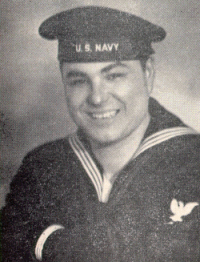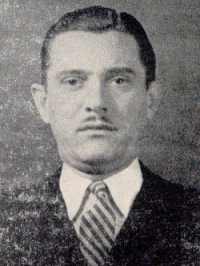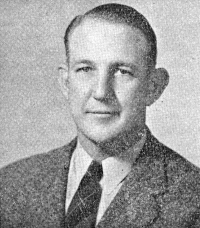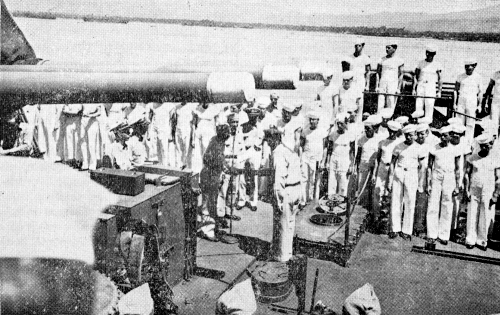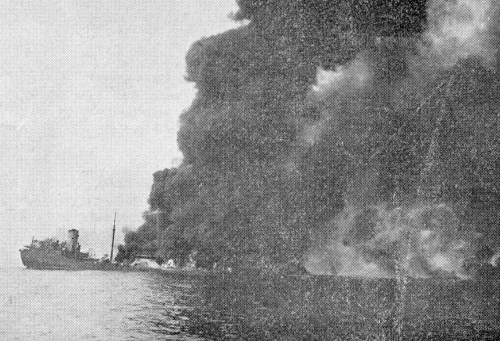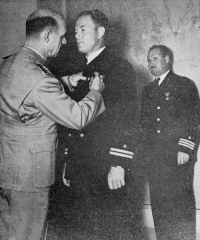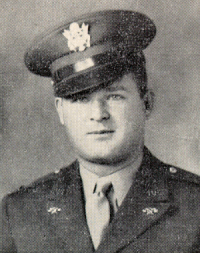|
Running
Lights-- War and the U.S. Navy are not new to Chief Cody. In World War No. 1, he participated in mining the North Sea and witnessed the surrender of the German Fleet at Scapa Flow and the subsequent scuttling by the crews. Then Erv and his pals went back and picked up the something over 54,000 mines that they had laid, from Norway to the Orkneys and destroyed them. After the war Erv attended the Navy Diving School and held the Navy's Diver's certificate. He became one of the regular divers on Fire Boat No. 2, after joining the Fire Department. Later he took command of Fire Boat No. 3 and there the Navy found him and called him hack to duty at the start of the present war. Here's to you, Chief "Torps" and we know you will be a credit to your new position as you have been to the positions you have held in the past. Comment a la Jack Gordon:---Boy ol' Erv sure looked good in his new uniform when he went away . . . . D o g g o n e we're gonna miss him at the Boat.
|
|||||||
|
|||||||
|
|||||||
|
Press dispatches from England credit a member of the Los Angeles Fire Department with the downing of a ME-109 whose pilot had made a head-on attack on a Flying Fortress. This man, Lieutenant Monroe Hotaling, group gunnery officer of the Fortress, firing from a difficult angle, blew up the enemy fighter under the bomber's right wing.
Hotaling, a captain, came into the department in 1929. He was first at 6s, where he spent some years, from there going to 28s and then to 59s, from where he enlisted. Completing his instruction at the bombardier school he emerged a lieutenant and has long been in England, participating in many raids over the continent. The plane which participated in the raid above mentioned was the Flying Fortress Rene the Third, bought with War Bonds purchased by employees of the Douglas Aircraft plant at Long Beach, and built by the same workers. She carries an album containing the names of the part of the ship that each built.
Lieutenant Hotaling resided at 1922 Granville avenue, West Los
Angeles. His brother, Harry, is a retired captain of the
department. |
|||||||
|
MANY tales of heroic activities have come out of this war. Men have unhesitatingly risked their all under circumstances which allowed but slight chance of escape with their lives and these, in the main, have been under high emotional stress, where life was pitted against life, and excitement brought herculean effort. These men are entitled to the adulation of respect of the nation and nothing could be said to detract from their achievements.
There are also those who, without the fanfare of battle, daily pursue their duties, accepting hazards dangerous to the extreme, yet are seldom mentioned in the news dispatches. Theirs is a duty where split-second timing, coupled with years of training and aloofness to personal danger has performed miracles in the saving of lives and property. Such an act on the part of Lieutenant (jg) Lawrence J. Clarke, U. S. Naval Reserve, U.S.S. Phoenix, brought a commendation from the Navy Department January 31, 1944 which was presented to the Lieutenant with congratulations on board his ship March 11, 1944. Lieutenant Clarke, Captain on the Los Angeles Fire Department, boarded a burning ship in the Chesapeake channel on June 1, 1943 in company with his fire-fighting party and there, facing great danger from explosions, gases and burning vapors, successfully fought a blaze which might have caused serious loss of life and material.
The cold words of the citation hardly paint an appropriate picture of the dangers involved in such an operation. No one not having experienced such a fire can visualize its immensity and hazards. Treading the heat-warped deck of a vessel filled with aviation gasoline, where momentarily might be anticipated a life-snuffing explosion, calls for more than mere bravado. It exacts not only a lack of concern for personal safety, it brings into action that knowledge gained from years of training where advantage is taken of every opening that fire may be quenched and danger eliminated. And not only the mechanics of fire-fighting must be demonstrated, there must also be that confidence of the personnel in its leadership to where a cohesive front is established and maintained. While heroic acts are being performed hourly in this world struggle it is but natural a degree of pride should be felt by the Los Angles Fire Department that Lieutenant Clarke was one of its members and received his training here. He entered the service from Truck 29. Previously he had been at 20s. His record on the department is of the best and his being the recipient of honors from his country is no surprise to his comrades.
|
|||||||
|
Following is the commendation he received from the Navy Department over the signature of L. E. Defield, Assistant Chief of Naval Personal:
Under
the heading "First Endorsement" of the records of the
Navy Department is recorded the presentation of the citation to
Lieutenant Clarke aboard his ship with the notation,
"delivered with congratulations." |
|||||||
|
|||||||
|
By H. J. GRIFFIN, Captain, Retired THE present drive of our army through France brings back memories to us soldiers of 1917-1918. A lot of the boys, like myself, fought through the same ground. St. Nazaire, a nice harbor and city, Brest, a harbor of fog and rain; Le Mans, Tours, Angiers, Paris, all big cities, and a volume of villages. We suppose our boys are there getting the old French words such as Les Erfs (eggs), Pom de teers (spuds), Fromage, Vin de Blanc (white wine), Vin de Rouge (red wine), Fere de Laporte (shut the door), Promade Madame (go for a walk Mrs.), then the words Fini le Bosch (finish the Germans), Fini the La Guerre (finish the war), Soldat (soldier), and a lot of other words. The French are a polite, friendly people, war weary, and soil trodden with the feet of enemy for centuries. But how can we of 1918 and boys there now ever forget the nice pile of refuse from cow barns that is in front of most all houses in villagers of the farming sections. Then to turn to the same gang of today that fought under another German name in 1918--now led by Hitler and his gang of pack wolves, I suppose the same old signs are everywhere, namely "Verbooten" forbidden. Also the same black bread, made of sawdust, and the soup carts, all of which follow the German army. It is the same old bunch, the same old German form. We are good if we have the enemy on the run, but let them get us on the run--we never stop--so it will be the same in war over there now--when the wolves see that our army is stepping on the soil of the Fatherland--let's throw in the sponge--quit fighting --you will see as soon as soldiers of U. S. or Allies step on the home of beasts (Germans) they are not fighting any more. I can still picture in my mind (just as of today) the thousands of German prisoners marching back to prison pens. We cannot stop this time at borders of Germany. We must and will occupy the entire German nation, and police and watch for plotting for another war. Our dead comrades on the battlefields are trusting us to see that the Huns--so-called Germans--are put to sleep forever--as to their last ambitions with wars. A little incident comes to mind, around 1941. A big Jap tanker slips into San Pedro harbor, docked, and a Jap officer came ashore, made his way to a fire station and, bowing with all the dignity of grace, met a fireman and thus spoke the Son of Japan: "Veery nice fire station--you have lots nice oil tanks here--veery nice place." No doubt the eyes of this Jap were mapping the place for his country--yes, very courteous. After this little talk the officer, bowing, said: "I tank you veery great--I tell Emperor about it." And I suppose he did. Then the time when we used to see the Jap soldiers on leave here, being shown all over the city, showered with more courtesy than afforded us. Little did we think then that these slinky, smiling sons of the rising sun, would some day stab our beloved soldiers, marines, sailors in the back. Never again must we trust these Japs. We will hold the mighty sword to strike with all the fury of a giant if these sons of the rising sun ever again try to prepare for war.
And so goes the war news. Soon the Emperor, his war lords, the
once mighty Hitler and his gang of murderers will soon be gone, and
once more the sun will shine upon peoples of the world. But
let's not forget our fallen heroes that sleep upon the soil of
Pacific islands and Europe. "Lest we forget," they
died that we might be free. Let's not forget them.
Source: The Fireman's Grape Vine, September 1944 |
|||||||
|
|||||||
|
Word was received recently that Lieut. Donald W. Smith, USNR, on military leave form the Los Angeles Fire Department, received the Commendation for "outstanding performance of duty as Assistance Material and Logistics Officer on the staff of a Naval Task Force Commander during a period of continual operations against the enemy in the Central Mediterranean." Participating in the landings at Sicily, Salerno, Anzio, and Southern France, Lieutenant Smith's records were kept with such accuracy and completeness that they furnished an excellent basis and were utilized for logistical planning purposes. In addition his information and advice on fire prevention aided materially in minimizing the fire threat during these operations, the commendation continues. Lieutenant Smith is at present Fire Protection Officer and Assistant Maintenance Officer of the Training Command. Presentation of the award was made by Rear Admiral G. H. Fort, USN, ComPhibsTraPac, before a group of staff officers.
Lieutenant Smith was appointed to the Los Angeles Fire Department
on November 24, 1935, and went on military leave February 5,
1943. While on leave he was promoted to the rank of
autofireman December 1, 1943. His last station before going
into service was Engine 28A. |
|||||||
|
Joseph P. Bean, who joined the Los Angeles Fire Department November 19, 1940, serving at 29s and 27s, and enlisting in the armed service during May of 1942, is the recipient of the Bronze Star Medal, July 4, 1945, with the following citation:
Mr. Bean was commissioned at Edgewater, Maryland, in chemical warfare. Was afterward transferred to the field artillery, going overseas in June, 1944. He was wounded in France of September, 1944, after having seen service in Italy, France and Germany. He is now stationed near Munich, Germany, and has been promoted to the rank of Captain of the Field Artillery. Bean
was born in Los Angeles April 4, 1915. He attended St.
Cecilia and St. Brigid grammar schools, graduating from Loyola
high school. He completed his scholastic work at Pepperdine
college, Los Angeles City College and Texas A. & M. |
|||||||
|
The following are excerpts taken from monthly articles contributed to the Firemen's Grapevine during the war years by Stanley E. Halfhill. |
|||||||
|
By Stanley E. Halfhill January 1,
1942 Freedom! Not a word, but a way of living, of believing. Why we don't know anything else. We could never know anything else. And we never will! Happy New Year? With Hawaii still burying her dead. With Luzon invaded. With three hundred and fifty American boys fighting to the death for a mere sandy spit of American soil thousands of miles from home. With thousands of our men aboard their floating fortresses but in danger of their lives this minute. Happy New Year! Ha! Next year maybe. But right now we have a job to do. Eventide They always seemed to be so alive--so full of spirit. Though they never won the fleet championship they were always in there trying and never seemed to care that the "Cal" and Pennsy" had them outclassed. When we read of some of them swimming through waters covered with flaming oil to reach another ship, when the old Arizona died beneath them, we thought of the spirit they had shown on the gridiron. So when they reached another ship and promptly helped man her guns to fight some more, it was only natural--they being that kind of men. The last time we saw the Arizona she was lying out at her anchorage in the Los Angeles Harbor in solitary splendor. She had her war paint on consisting of dark, smoky hull and fighting top of lighter gray. On her bow was painted an immense blue bow wave--and she was all alone. Gone were all her sister ships, big and small, hither and yon on many mission, and she was only to stop for two days, at her old home, and then away again. That may have been her last trip to the States. You see, it wasn't so long ago. When she slipped to sea again, too soon to keep her rendezvous with treachery and murder, aboard was still that love of sportsmanship. That will to keep on fighting against any odds, that was her heritage. This week, reported in the newspapers, was the bitter vow of one of her survivors: "After that stab in the back I hope to live to show them what an American can do." Running Lights We found at quarters there a fireman with a problem. In his pocket was a private flying license and he told me that he loved to fly but his plane had been grounded along with all private flying. Too, he had only four months to go before he would be too old to get in the Air Force. The security of marriage and steady employment was his but still, he loved to fly. His country needs flyers. And daily before his eyes a parade of some of the finest planes and pilots in the world--just to make it tougher to decide to stay home and fight the battles of home defense, which surely is the job of the fireman in this war. So Fireman Blank thinks that is quite a problem. Blank is really his mane, too. Say Blank, how's to swap, eh? You write Eventide and we will join the Air Corps, huh? All Turrets
Theodore Roosevelt once said," No man is worth his salt who is not
ready at all times to risk his body, to risk his well-being, to
risk his life in a great cause." |
|||||||
|
PEOPLE of the Los Angeles Harbor area have been cautioned by press and radio to say nothing to anyone about the movements of ships either in or out of the harbor during the war. The reasons are obvious. As one commentator said, "Ships coming and going can be plainly seen by inhabitants of the area, but it is just possible that the enemy may not know about it if the residents make a habit of saying nothing." Well, maybe so. But if there is a fifth column in the Harbor area that functions with one-tenth of the efficiency of the one in Honolulu, as is now a matter of record, then there will be precious little about our harbor that the enemy will not know intimately. The topography of the district being what it is, it would be impossible to hide much on the waters there. From many vantage points, along the lonely roads that wind through the Palos Verdes hills, the whole panorama of the harbor and its environs spreads like a map far below. There used to be high-powered telescopes set along some of the higher promontories, where for the small sum of "a thin dime" one could bring Fort McArthur or Navy's Reeves Field right up to the eye. It was like having a ringside seat to any "doings" anywhere down below. Of course, the Japs farmed all of that area for years and it never seemed important to the ordinary citizen then. That they probably watched our fleet, as it came and went, from their high fields along the shoulders of the hills, seems now to be only a matter of course. We know that other Japs followed our Navy in local waters in their tuna boats and had to be driven away from San Clemente Island, a Naval reserve. The little yellow men were busy those days, sizing up the big complacent behemoth that they were to treacherously attack, come the day. We remember one time accompanying Cap (now Chief) Danks, and Keith Danks on an abalone trip out toward Portuguese Bend and when we would have gone down through a field toward the ocean, we found our way blocked by a Jap's garden truck and curtly refused entrance. There may have been no significance to that incidence but if the Jap had something to hide he was in a particularly advantageous point for it, being at a place where he could watch the whole Catalina channel. It was in '38 that we stood on a high knob above Fort McArthur and watched the whole Pacific fleet pass in and out of the outer harbor, in a test of the capacity of the Los Angeles harbor to hold the entire fleet at one time. We proudly pointed out to our Dad, who was a visitor from the East, the different units in the various columns of ships. We found it to be a thrilling sight. We suppose that the short-wave sets were busy that night, on the Palos Verdes, near by. Having catalogued, as well as counted, our ships and noted their doings, the little yellow devils, come night fall, had left their tomatoes and cabbages and turned on their power-radio sending sets and reported to other hirelings of the Mikado, that which they had seen. We fancy that it is a different story up in the Palos Verdes, these days. The army is certainly there and if there be any telescopes, any radios, they are manned today by loyal Americans in khaki uniforms and what they are doing is their business but we'll lay you two to one that they are not growing any tomatoes. Speaking of telescopes--there is one not far from here and the boys, who daily scan the ocean are those same boys in khaki. Day and night a watch is kept and not long ago one of them was rewarded by a great thing to see. He saw the attacker of the Absaroka blown to pieces by a Navy bomber and that must have been a satisfying sight to any American. We saw this same ship laying on the sand at Cabrillo beach the other day and we can tell about it for she won't go anywhere for awhile with that torpedo hole in her side. In fact we saw many ships in the harbor but won't go into that. There was one though whose painting with the colors of war surely seemed odd. We refer to the Catalina and some how we can't picture that one with war paint on. She and her sister ships have been, for many years, gay excursion boats to the "Magic Isle" and with their white paint and colored pennants, have been the carriers of happy vacation-bound people and, well, she just won't fit into the war scene.
It looks like, now, that it will be impossible to continue writing
about the harbor, at least of things that we normally discussed on
these pages. We are at last in the position of having an empty
stage and even the stage is taboo. We mean that the moving
characters have gone and the props alone remain and they shrouded in
darkness. The play is over. A new one will soon
begin. Title? Remember Pearl Harbor! |
|||||||
|
We walked out on the breakwater at Cabrillo Beach and gazed around us in amazement. Without question there had never been seen such a massing of implements of war since the Spanish Armada. And what implements of war! Massive flying boats of multi-decked height and wings of enormous spread, anchored in windrows of countless thousands, behind the breakwater and over the surface of the Los Angeles harbor, clear to the dim outline of Long Beach in the distance. Why, the miles of space was crowded with them and still they were coming. Every few minutes could be heard a hum that crescendoed to a roar and from out of the sky, from north or south, or east would come another great bird to land on the sea outside and come taxiing in past the breakwater light house and thread its way through the labyrinth of sister ships, to an anchor buoy, in the middle distance. On their bows was painted the stars and stripes, like the Pam American Clippers, but on their wings was the blue star-with red field center-on a white field, of the Naval Air Forces. How they bristled with guns! We had no idea that flying ships, even such mammoth ones as these, could mount such enormous guns as protruded from the wings, the turrets and blisters of these flying fortresses. We guessed that they must be somewhere from three to five-inch bore.. It was so hard to tell, but compared with the size of the flyers that were swarming over them, waking on the wings and clamboring up and down the fuselages, the guns must have been that big at least. From the feverish activity that was going on, we surmised that this great fleet was in a hurry to cast off in the near future. Many Navy launches were weaving to and fro from the pier to planes and back in never ending streams. We sat down on the breakwater's edge to see what this was all about. We watched a heavily laden shore boat make its way out to one of the nearer flying battleships and pull up to the bow. Big doors immediately opened and an I-beam traveling crane came into view and the sailors in the boat fastened the business end of winch to an aerial torpedo or bomb of the same size and it slowly raised and disappeared into the maw of the plane. This was repeated many times and then the boat shoved off with a tinkling of the coxswain's bell. Soon another took its place and this performance was repeated many times. Our surprise at the size of these ships was gradually replaced with a wonder at the capacity of them. Holy Cow! How many of those big tin fish and bombs could these planes hold any way? As we looked across the harbor toward Watchorn Basin and out past the reaches of the outer harbor, clear to Reeves Field we could see this same work going on in a hundred different places on a hundred different planes. Also here and there could be seen oil lighters with their flexible hoses reaching up to and into wings as they dispensed gasoline to the moored and silent war birds. Our concentration on the scene before us was presently interrupted by a voice at our side. Turning, we saw sitting close by, a little fellow in a black hat perched atop a big round head, dark clothes and the inevitable horned rim spectacles. Black brows and squinty little slanted eyes were the main features, along with buck teeth and a blob of a nose, of a particularly unattractive face. He seemed vaguely familiar. Evidently a Jap. But certainly a Jap. "You say--how many planes--you see, huh?" Pad and pencil poised, the little guy waited for the answer. We still could not place him. We didn't answer. "You say . . . Maybe so two t'ousan' . . . Maybe twen' five hundled planes?, quizzed the little Nipponese, unabashed by our close scrutiny, as we tried to place him in our memory among the many Japanese faces we had seen in the Harbor District, during four years of residence there. For some unbeknownst reason we found ourselves answering this fellow. We told him, "Look here, there are many thousands of planes there and many more are coming, every minute, every hour, every day." This sudden reply seemed to agitate the little fellow some what. He jumped up and spluttered--"Oh, too many--too many. Where they go, huh? Yu know where they go? We didn't. But we found our voice saying, "To Tokyo, tonight!" That got the Jap. He jumped and shook his head and hurried away, saying "Oh! Oh! Too many, too big! Oh, too bad!" He scurried in toward shore, his short legs taking him up and down over the uneven rocks at greater speed than we would have thought possible. We murmured to ourselves, "Make the most of that, Mr. Moto." Mr. Moto? So that's who he was. Sure, unconsciously the name had come back to us. Why that was the face in all of the cartoons of today, depicting the Japs in general. But he had been here in person? There was such a squint-eyed monstrosity! Impossible. We scrambled to our feet, much perturbed, and looked around and lo and behold the Harbor was suddenly empty and did a fade out, right before our eyes-- We woke up in our little trundle bed in the Valley and the little woman had given us the old elbow with the wifely admonition, "Daddy! Get off you back, Your snoring again." Dutifully rolling over, we snuggled down warmly against the chill of an open window, nearby, and drowsily we wondered about all of these mighty planes we had seen while in the arm of Morpheus, and again we said to ourselves, "Make the most of that, Mr. Moto."""""
|
LAFIRE.COM
Copyright 2000 All Rights Reserved.
